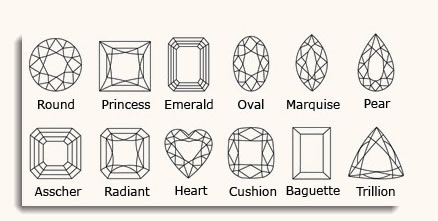Choosing A Diamond: The 4 C’s
Whether buying loose diamonds for custom made jewelry or choosing the right engagement ring, selecting a diamond is an essential part of finding a piece that you love at a price you can afford.
At Saettele Jewelers of St. Louis, we want you to be comfortable with your purchase and understand the diamond you are buying. Here is a quick course on choosing the best diamond for your engagement ring:
Get In Touch With Saettele!
Enter your information below or call 314-725-8182 to get in touch with a Saettele representative.
Color
Diamonds are valued by how closely they approach colorlessness—the less color, the higher the value, and the rarer it is. Each letter grade has a clearly defined range of color. GIA’s color scale begins with D, representing colorlessness, and continues to increase the presence of color to Z for diamonds that appear light yellow or brown.
Diamonds are color-graded by comparing them to master stones in a controlled environment. Many diamond color distinctions are so subtle that they are invisible to the untrained eye. However, these slight variances make a very big difference in the quality and price of a diamond/
Clarity
Diamond clarity refers to the absence of inclusions and blemishes. Clarity grades are based on number, size, relief, or positions of inclusions and blemishes that can be seen under 10x magnification. Inclusions and blemishes are the natural result of a diamond’s formation deep within the earth under extreme pressure and heat. Diamonds without these “birthmarks” are very rare, which affects their overall value.
Cut
The cut of a diamond is the factor that fuels a diamond’s fire, sparkle, and brilliance. Precise workmanship is required to cut a diamond so its proportion, symmetry, and polish maximizes its beauty. The allure of a particular diamond depends on its cut more than anything else. The quality of the cut made is crucial to the diamond’s value, and out of all of the 4 C’s, is the most complex and technically difficult to assess.
Carat
Carat weight is the measurement of how much a diamond weighs. A metric carat is defined as 200 milligrams. All else being equal, diamond prices increase with carat weight because larger diamonds are rarer and more desirable.
Social Awareness
Saettele Jewelers is committed to selling precious gemstones and diamonds that were mined through socially and environmentally responsible means. We demand that all of our diamond suppliers have been purchased through legitimate, conflict-free sources.
It is and will always be our policy to purchase loose gemstones that have been approved through the Kimberly Process. This process is a joint initiative between governments, industries, and civil societies to stem the flow of conflict diamonds, rough diamonds used by rebel movements to finance wars against legitimate governments. The Kimberly Process imposes extensive requirements on its members to enable them to certify shipments of rough diamonds as “conflict-free”.
Abiding by the rules and guidelines of the Kimberly Process ensures that we never purchase from regions of the world where trading in such gemstones funds governments and other groups engaging in human rights violations.
In a global business like jewelry, we feel that our commitment to community extends far beyond the local area that we directly serve and represent.
Lab Grown Diamonds
When choosing diamonds, you should also consider lab grown diamonds. These diamonds are a beautiful, sustainable, and ethical alternative to naturally occurring diamonds. Since they are grown in a lab, these diamonds do not violate human rights or harm the environment.
Lab grown diamonds are chemically and physically the same as naturally occurring diamonds and can be created in the rare Type IIa with superior purity, brilliance, and fire. They are perfect for any budget as lab grown diamonds can reduce the cost of jewelry up to 40%. That means you can get a large, high-quality diamond and save.
Learn more about lab grown diamonds and their significant benefits.




